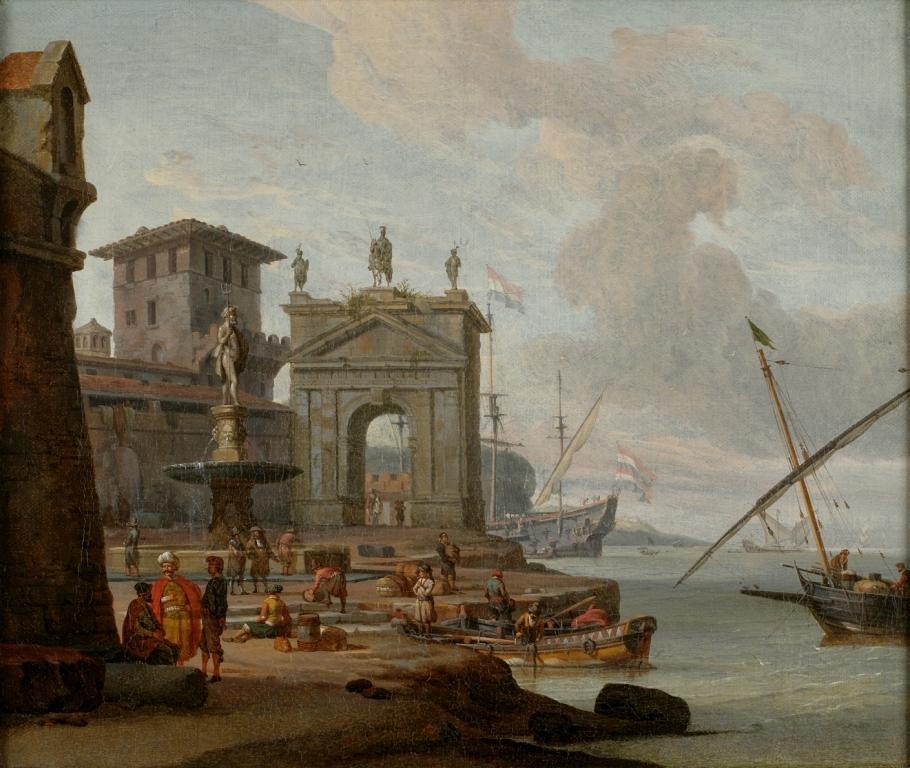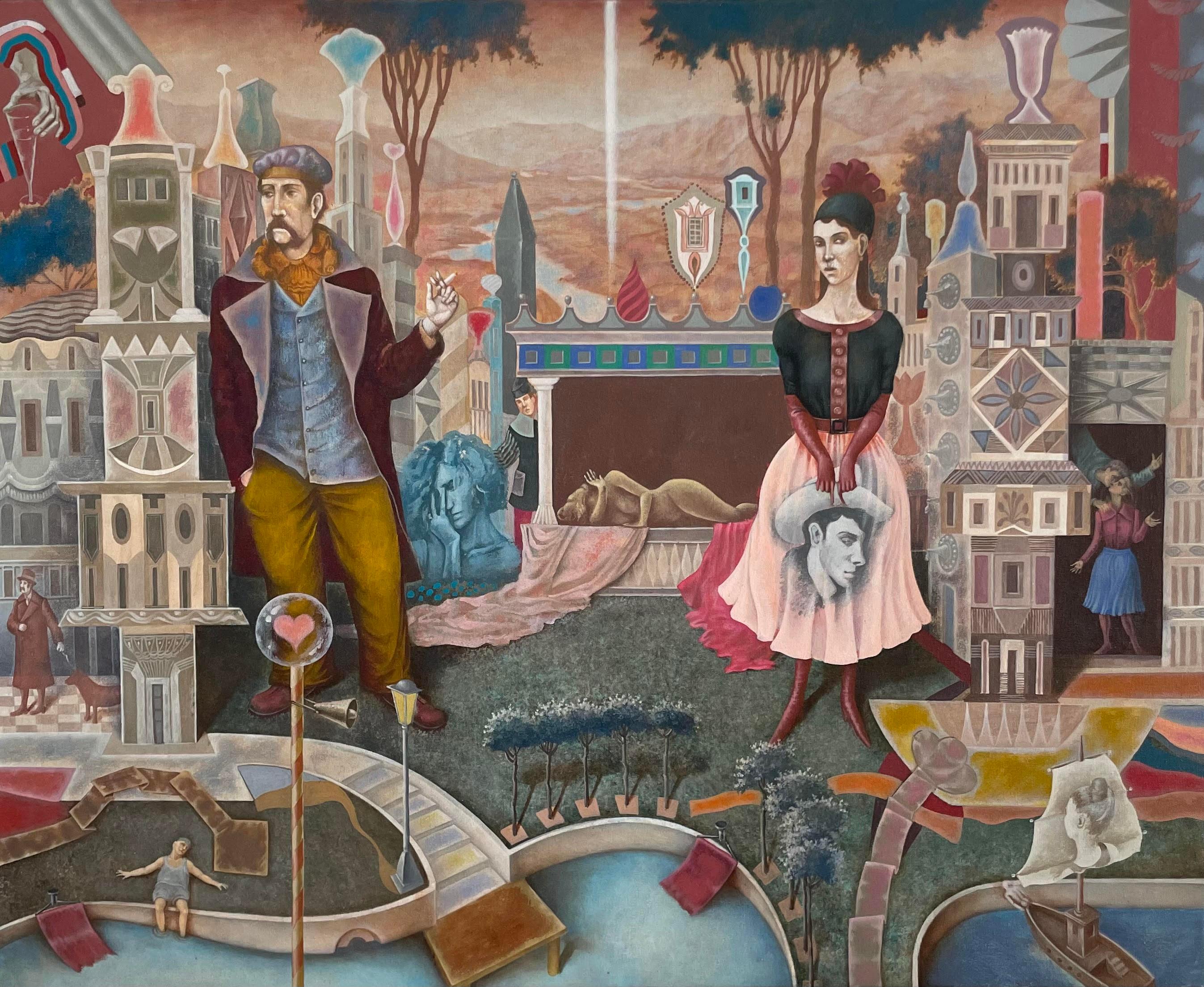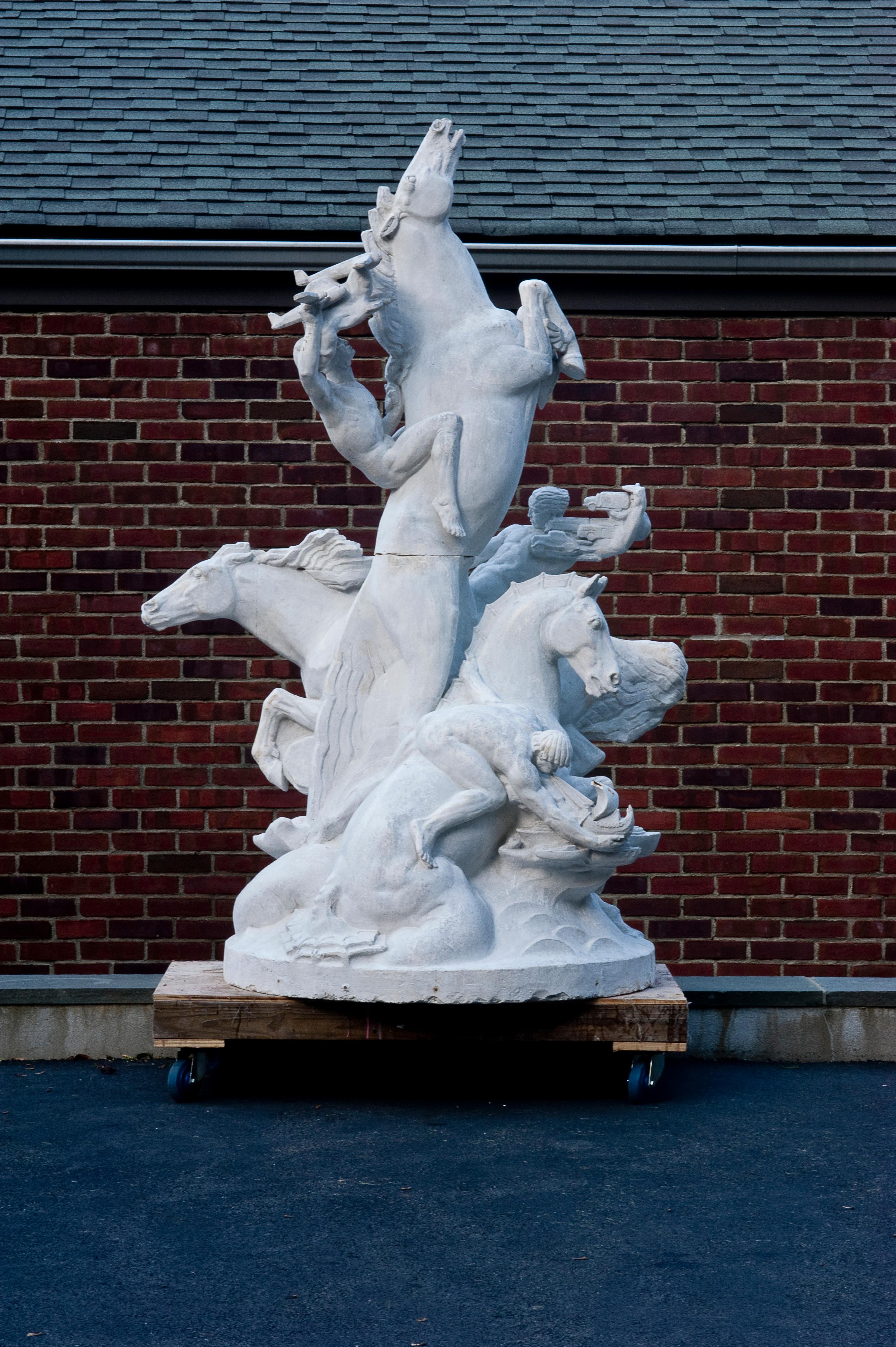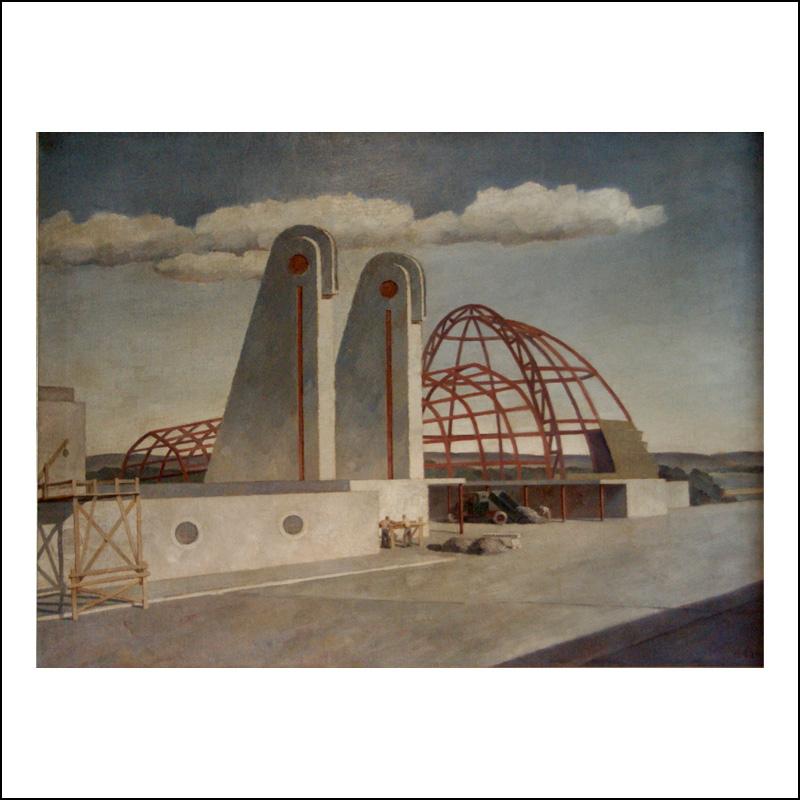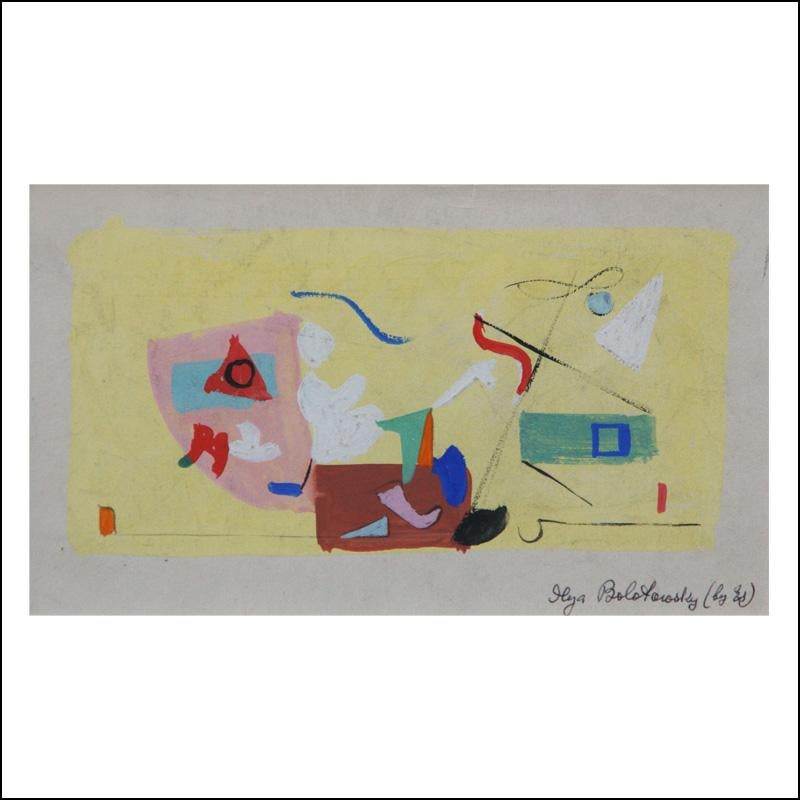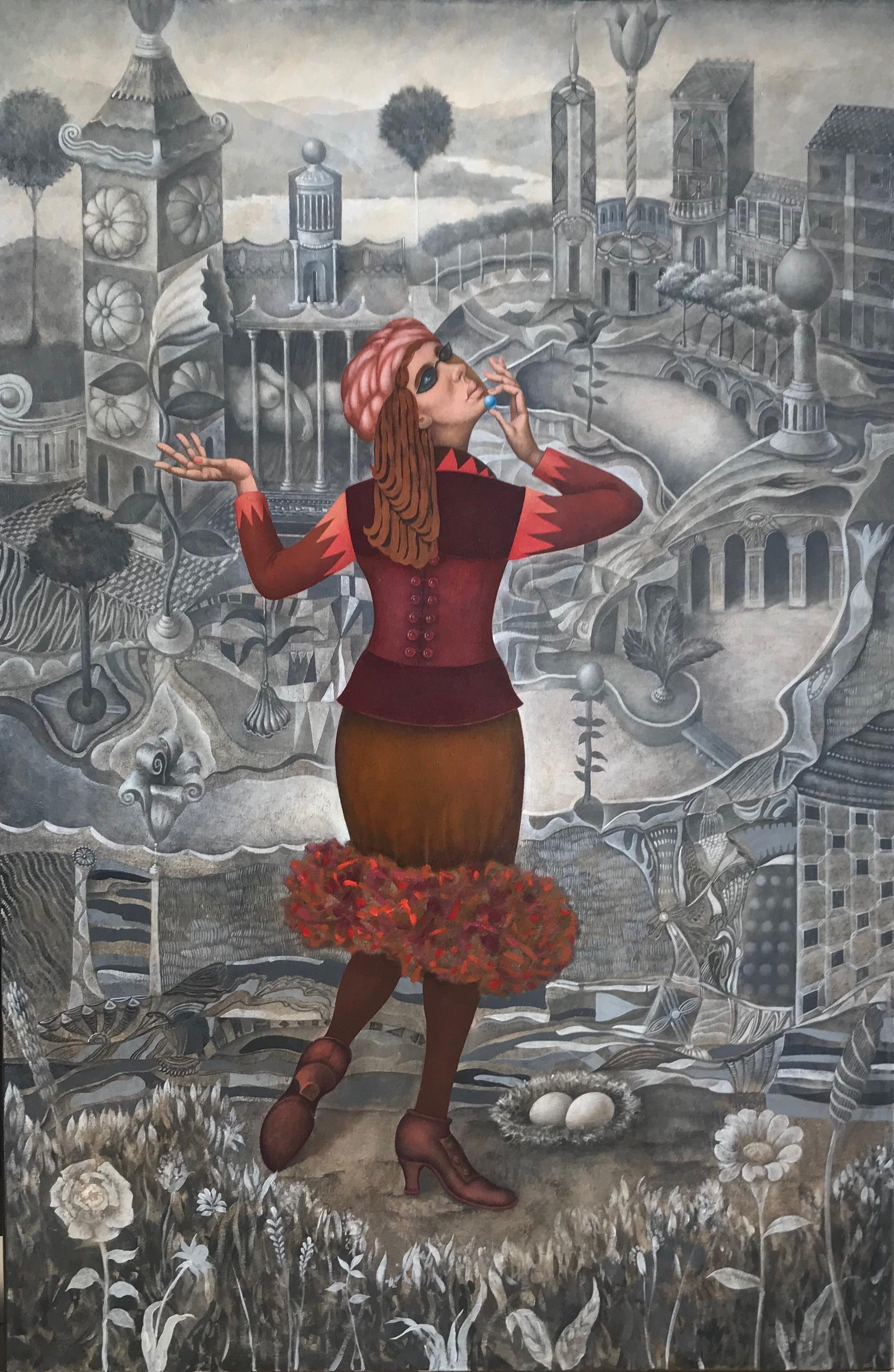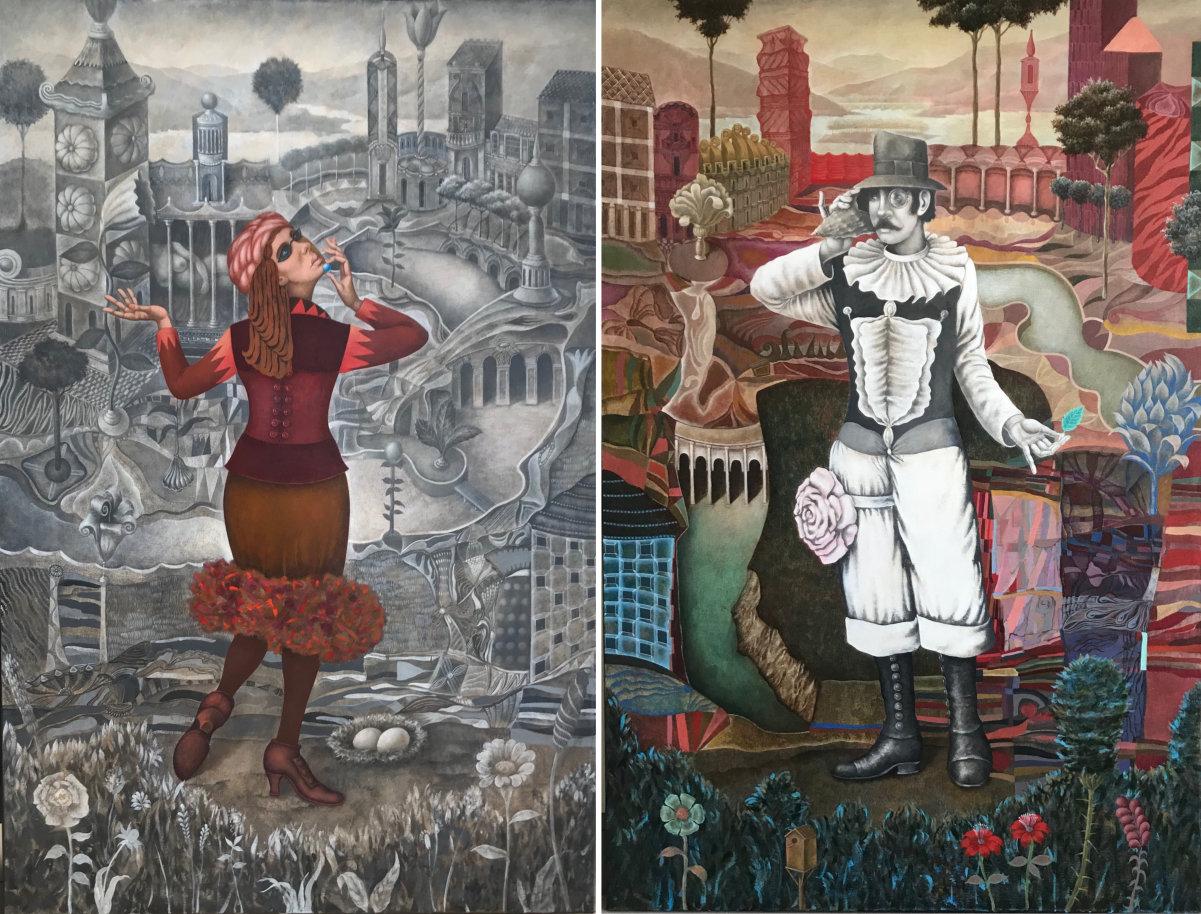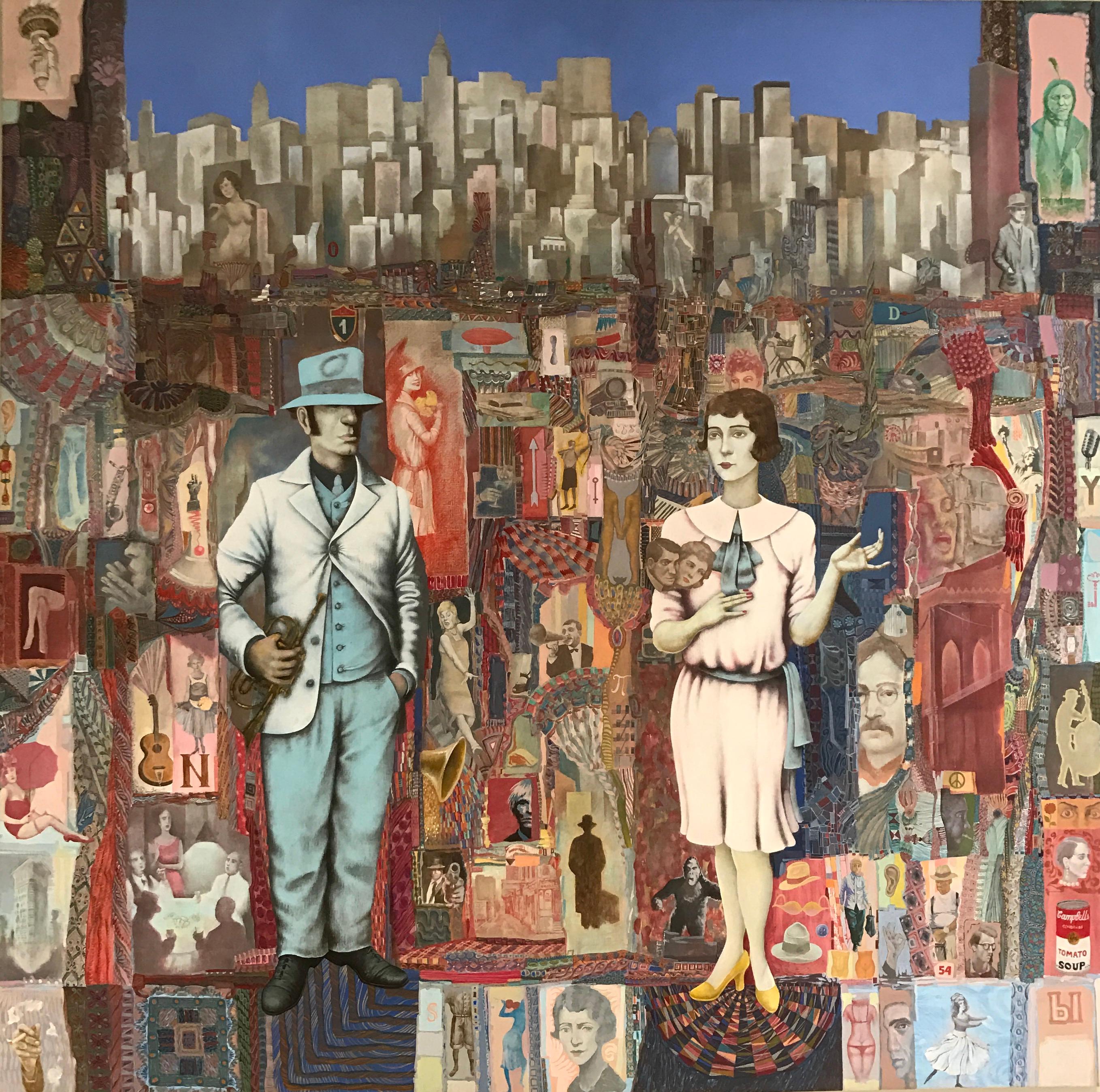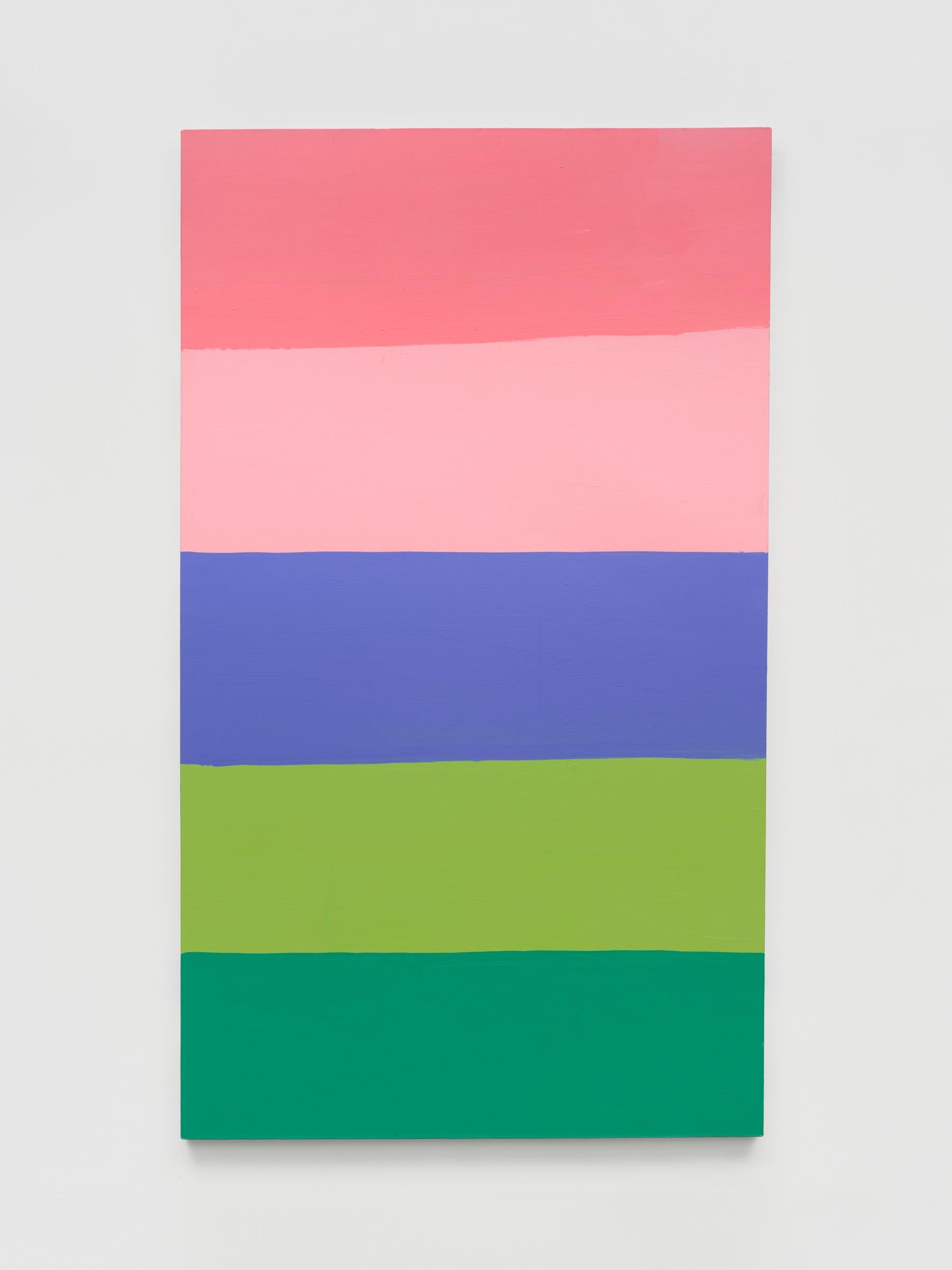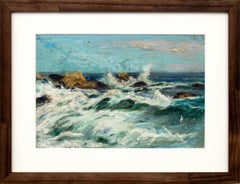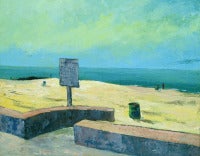
Capitola Beach, Southern California
View Similar Items
Jon BlanchetteCapitola Beach, Southern Californiacirca 1955
circa 1955
About the Item
- Creator:Jon Blanchette (1908-1987, American, British)
- Creation Year:circa 1955
- Dimensions:Height: 16 in (40.64 cm)Width: 20 in (50.8 cm)
- Condition:
- Gallery Location:Denver, CO
- Reference Number:Seller: 106121stDibs: G14030327390
Jon Blanchette
Jon Blanchette was born in Somerset, England, in 1908. He immigrated to Battle Creek, Michigan, in 1918. Artistically inclined at age six, he later studied at the Pittsburgh Art Institute, where he received his BA. In 1932, Blanchette moved to Los Angeles, where he painted, did the architectural design, interior decorating and stage sets for Fox Studios. In 1948, he settled in Aptos, California, where he painted fine art and taught privately. During the summers of 1965–75, Blanchette held workshops in Mendocino. A romantic realist, he was primarily an oil painter but was also proficient with pen & ink, watercolor, and silkscreen. Blanchette died in Aptos in 1987. He had a membership for the Santa Cruz Art League and Marin County Artists. Blanchette exhibited at Santa Cruz Women's Club, 1959, and stood first in the Santa Cruz County Art Competition, Aptos Art Center, 1965.
(Biography provided by Robert Azensky Fine Art)- Crashing Waves and Rocks, California Coast, 1920s Seascape Marine Oil PaintingBy Charles Partridge AdamsLocated in Denver, COVintage marine seascape oil painting of waves crashing on rocks along the California coast by Charles Partridge Adams (1858-1942). Colors include blue,...Category
1920s American Impressionist Landscape Paintings
MaterialsOil, Canvas
- Southwestern Landscape Painting, Lightning Storm over Mountains, Semi AbstractLocated in Denver, COOriginal vintage painting of a Lightning Storm, Southwestern Mountain Landcape. Oil painting on textured board by Morton Lawrence Schneider (1919-2000). This large scale semi abstrac...Category
20th Century American Modern Landscape Paintings
MaterialsOil, Board
- Mountain Landscape, Colorado Springs, Colorado, Framed Landscape Oil PaintingLocated in Denver, COMountain Landscape, Near Colorado Springs, Colorado is a vertical oil on board painting by Mary Cane Robinson. Presented in a custom frame, outer dime...Category
Mid-20th Century American Modern Landscape Paintings
MaterialsOil
$3,563 Sale Price24% Off - Ed Sketching at Red Rocks, Vintage 1940s Original Mountain Landscape, ColoradoBy Vance KirklandLocated in Denver, COOriginal vintage 1940s Modernist Landscape painting of Red Rocks Park, Colorado by Vance Kirkland (1904-1981). Titled, "Ed (Hicks) Sketching at Red Rocks". This regionalist mountain landscape painting is set near Red Rocks Park, Morrison, Colorado (just west of Denver). The figure in the painting is of Kirkland's friend, Ed Hicks. Watercolor on paper, signed and dated, January 1943, lower left and titled verso by the artist. Painted in colors of red, brown, blue, and green. Presented in a custom gold leaf frame, outer dimensions measure 34 ¾ x 42 ⅞ x 1 ¼ inches. Painting as shown within the mat and frame measures 21 x 29 inches. Provenance: Private Collection, Denver, Colorado About the Artist: Variously referred to as the “Father of Modern Colorado Painting,” “Dean of Colorado Artists” and “Colorado’s pre-eminent artist,” Kirkland was an inventive, visionary painter who spent fifty-two years of his fifty-four year career in Denver. Of the approximately 1,200 paintings he created, about 550 from the first half of his career (1927-1953) are water-based media: acquarelle, gouache, casein and egg tempera, with a few oils. In the latter half of his career (1953-1981) he used oil and his unique oil and water mixture. He also produced five hundred drawings and some ten prints, mostly lithographs on stone, while also engaged in teaching full-time for most of the period. To show people “something they have never seen before and new ways to look at things,” he felt he needed to preserve his artistic freedom. Consequently, he chose to spend his entire professional career in Denver far removed from the established American art centers in the East and Midwest. “By minding my own business and working on my own,” he said, “I think it was possible to develop in this part of the country… I’ve developed my kind of work [and] I think my paintings are stronger for having worked that way.” The geographical isolation resulting from his choice to stay in Colorado did not impede his creativity, as it did other artists, but in fact contributed to his unique vision. The son of a dentist, who was disappointed with his [son’s] choice of art as a career, Kirkland flunked freshman watercolor class in 1924 at the Cleveland School of Art (now the Cleveland Institute of Art) for putting colors into his landscapes that did not exist in nature and for competing colors. Not dissuaded, he won first prize for his watercolors in his junior and senior years. [While in Cleveland,] he studied with three influential teachers. Henry Keller, included in the prestigious New York Armory Show in 1913, introduced him to designed realism which he later used in his Colorado landscapes in the 1930s and 1940s. His other teachers were Bill Eastman, who studied with Hans Hofmann and appreciated all the new movements in modern art, and Frank Wilcox, a fine watercolorist. While a student at the Cleveland School of Art, Kirkland concurrently took liberal arts courses at Western Reserve and the Cleveland School of Education and taught two freshman courses in watercolor and design, receiving his diploma in painting from the school in 1927 by doing four years of work in three. The following year he received a Bachelor of Education in Art degree from the same institution. In 1929 he assumed the position of founding director of the University of Denver’s School of Art, originally known as the Chappell School of Art. He resigned three years later when the university reneged on its agreement to grant its art courses full recognition toward a Bachelor of Arts degree. His students prevailed on him to continue teaching, resulting in the Kirkland School of Art which he opened in 1932 at 1311 Pearl Street in Denver. The building, where he painted until his death in 1981, formerly was the studio of British-born artist, Henry Read, designer of the City of Denver Seal and one of the original thirteen charter members of the Artists’ Club of Denver, forerunner of the Denver Art Museum. The Kirkland School of Art prospered for the next fourteen years with its courses accredited by the University of Colorado Extension Center in Denver. The teaching income from his art school and his painting commissions helped him survive the Great Depression. The U.S. Treasury Department’s Section of Fine Arts commissioned from him two post office murals, Cattle Roundup (1938, Eureka, Kansas), and Land Rush (1940, Sayre, Oklahoma). He also did murals for several Denver clients: the Gerald Hughes mansion (1936, later demolished), Arthur Johnson home (1936-37, Seven Drinks of Man), Albany Hotel (1937, later demolished), Neustetter’s Department Store (1937, “History of Costume,” three of five saved in 1987 before the building interior was demolished in advance of its condo conversion), and the Denver Country Club (1945, partially destroyed and later painted over). In 1953 the Ford Times, published by the Ford Motor Company, commissioned Kirkland along with fellow Denver artists, William Sanderson and Richard Sorby, to paint six watercolors each for the publication. Their work appeared in articles [about] Colorado entitled, “Take to the High Road” (of the Colorado Rockies) by Alicita and Warren Hamilton. Kirkland sketched the mountain passes and high roads in the area of Mount Evans, Independence Pass near Aspen, and Trail Ridge Road in Rocky Mountain National Park. In 1946 Kirkland closed his art school when the University of Denver rehired him as director of its School of Art and chairman of the Division of Arts and Humanities. In 1957...Category
1940s American Modern Landscape Paintings
MaterialsWatercolor
$15,400 Sale Price20% Off - Cabin Near Estes Park, Colorado, 1920s Landscape Oil Painting, Green Blue, GrayBy Randall DaveyLocated in Denver, COOriginal oil on board painting by artist Randall Vernon Davey (1887-1964) painted circa 1927. Painting depicts a wood cabin near Estes Park, Colorado. Mt. Meeker, Long's Peak, and La...Category
Mid-20th Century American Impressionist Landscape Paintings
MaterialsBoard, Oil
- Jagged Sea, 1960s Abstract Landscape Painting, Tones of Pink, Red, OrangeBy Margo HoffLocated in Denver, COAbstract acrylic on board painting by Margo Hoff (1910-2008) titled 'Jagged Sea'. Outer dimensions measure 37.5 x 41.5 x 2 inches. Image dimensions measure 36 x 40.25 x 1 inches. Provenance: Estate of the artist Painting is in good condition - please contact us for a detailed condition report. About the Artist: Born Oklahoma 1910 Died New York 2008 A prolific artist, Margo Hoff’s exquisite style evolved throughout her career yet was always rooted in the events, people, and places in her life. The human experience was her sole focus, expressed through her eyes alone. Born in 1910 in Tulsa, Oklahoma, Hoff began creating white, clay animals at a young age, giving them to her friends and family. At eleven she contracted typhoid fever and was bedridden for a summer. During her convalescence, she drew and made cutouts, and it was during this time that her bold, artistic imagination came alive. She began formal art training in high school and continued her education at the University of Oklahoma, Tulsa. In 1933 she moved to Chicago and attended the National Academy of Art and the School of the Art Institute of Chicago. Between 1933 and 1960, her Chicago years, Hoff’s work was deeply rooted in a figurative, regionalist style. She often used elements of magical realism, and many of her paintings have dreamlike qualities. As a child she learned about color by grinding down rocks, plants, and berries. Her color pallet during the Chicago years is indicative of her early, life color experimentation as she consistently used warm, earth tones in her work. Hoff was a born adventurer and traveled extensively. She lived, worked, taught, and painted in Europe, Mexico, Lebanon, Uganda, Brazil, and China. She also showed at the Denver Art Museum’s Annual Western Exhibitions in 1952, 54, 56 and 57. In 1957 she showed along-side Colorado modernist Vance Kirkland at the Denver Art Museum’s exhibition, Man’s Conquest of Space. What was once a focus on the representational, her work began to change after 1957 when she saw Sputnik in its orbit around Earth. At that moment, feet firmly placed on the ground, she was able to imagine herself in space, looking down from the cosmos, and what she saw was an abstracted world. She then had the opportunity to peer into an electron microscope where once again she was looking down into what seemed to be a realm of pure abstraction. These two events profoundly changed her perspective and she began to move from figural painting to abstract, geometric collage. In 1960, Hoff moved to New York City and she began creating collages. Placing the canvas on the ground, and working from all sides, she used strips of painted paper and tissue, and later painted pieces of canvas, glued onto the canvas surface, building layer upon layer, shape against shape, “action of color next to stillness of color.” She believed these simplified, abstracted forms held the spirit of the subject in the same way poetry reduces words to their essence. These pieces range from aerial cityscapes, to dancers in motions, to flora...Category
1960s Abstract Landscape Paintings
MaterialsAcrylic, Board
$7,996 Sale Price20% Off
- Mediterranean Capriccio, Oil on canvas by Abraham Storck, circa 1680By Abraham Jansz StorckLocated in Paris, FR« A Mediterranean capriccio » Oil on canvas by Abraham STORCK With an appraisal by René Millet ( Well Known French Expert in Paris) Within a tortoise-shell Turtle This oil on canvas...Category
17th Century Old Masters Landscape Paintings
MaterialsCanvas
- View Of A City, Animated Landscape by Jean Victor BertinLocated in Paris, FR"View of a city, animated landscape" attributed to Jean Victor Bertin. Oil on panel VB monogrammed, Circa 1830 Within its original giltwood frame from the same period. Dimensions without frame Height: 56 cm / 22 inches Width: 90 cm / 35.4 inches Dimensions with frame Height: 76cm / 30.7 inches Width: 108 cm / 42.5 inches Depth: 8 cm / 3.14 inches Certificate of authenticity Jean-Victor Bertin (1767-1842) was a French landscape painter of the neoclassical school. Considered as one of the masters of the historical landscape's school, he painted an abundant production influenced by Italy. Therefore, he is one of the most talented representatives of the landscape "adjusted" Italianate character and elegiac. He played the role of intermediate between the historical landscape and the romantic movement. His paintings are found in many museums : Beziers, Fontainebleau, Dijon, Honfleur, Rennes, Versailles, Angers, Autun, Carpentras, Cherbourg, Coutances, Evreux, La Fere, Lille, Quimper, Nantes, Reims, Rouen, Toulouse. Bibliography: Dictionary French landscape painters of the nineteenth century, Lydia Harambourg. Dictionary of the Little Masters...Category
1830s Landscape Paintings
MaterialsOil, Wood Panel
- Acquaintance - landscape of imaginary city made in pale pink, beige, blue, colorBy Igor FominLocated in Fort Lee, NJThe hero at this painting is a human. His eyes are a lenses that artist using. At all time they are together, a man and a woman. Duality of differences, two views, different accents,...Category
2010s Contemporary Figurative Paintings
MaterialsCanvas, Acrylic
- 1, 000 piece Museum Quality Collection of Art & Objects from NYC 1939 Worlds FairBy Chester BeachLocated in New York, NY1,000 piece Museum Quality Collection of Art & Objects from NYC 1939 Worlds Fair is available for sale. This sculpture, "Riders of the Elements," is the original 7' plaster maquette from the NYC 1939 World's Fair by Chester Beach...Category
1930s Art Deco Figurative Sculptures
MaterialsCanvas, Oil, Photographic Paper, Plaster
- 1, 000 piece Museum Quality Collection of Art & Objects from NYC 1939 Worlds FairBy Harry LaneLocated in New York, NY1,000 piece Museum Quality Collection of Art & Objects from NYC 1939 Worlds Fair Harry Lane (1891-1973) "1939 World’s Fair Construction," 30 x 40 inches, Oil on canvas, signed lower...Category
1930s American Modern Landscape Paintings
MaterialsPlaster, Photographic Paper, Canvas, Oil
- 1, 000 piece Museum Quality Collection of Art & Objects from NYC 1939 Worlds FairBy Ilya BolotowskyLocated in New York, NY1,000 piece Museum Quality Collection of Art & Objects from NYC 1939 Worlds Fair. Ilya Bolotowsky (1907-1981) "1939 World’s Fair Mural Study for the Hall of Medical Sciences...Category
1930s Abstract Geometric Abstract Drawings and Watercolors
MaterialsCanvas, Plaster, Paper, Oil, Gouache
